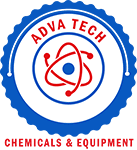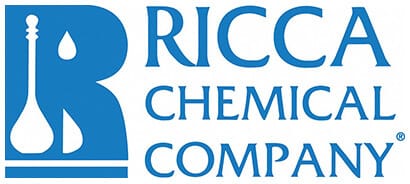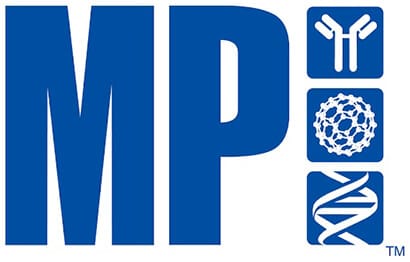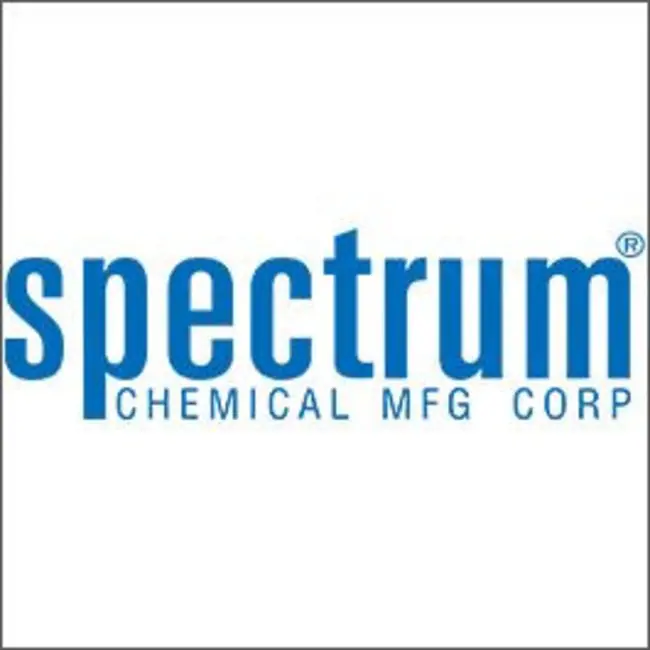Showing 29001–29050 of 36011 results
-
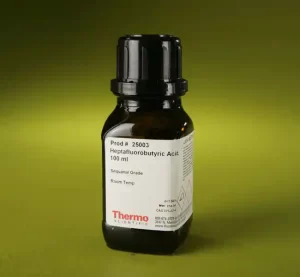
Thermo Scientific™ Pierce™ Heptafluorobutyric Acid (HFBA), Sequencing Grade
$699.20 Add to cart View Product DetailsThermo Scientific™ Pierce Heptafluorobutyric Acid (HFBA) is manufactured and tested to meet strict specifications that ensure superior performance for use as an ion-pairing agent in reverse-phase peptide separations.
Highlights:
- Typical purity is 99.7% by GC; <0.1% water
- Sequencing reagent for classical and automated Edman degradation of peptides and proteins
- Density: 1.645
- B.P. 120°C
- Packaged under nitrogen in amber glass ampules or bottles
- Clear, colorless liquid
Ordering Information:
X in the ordering table indicates that hazardous shipping charges apply
-
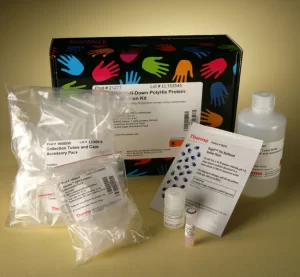
Thermo Scientific™ Pierce™ His Protein Interaction Pull-Down Kit
$632.50 Add to cart View Product DetailsThermo Scientific™ Pierce PolyHis Protein Interaction Pull-Down Kit purifies protein interaction complexes involving practically any user-supplied His-tagged fusion protein.
The PolyHis Protein Interaction Pull-Down Kit contains the necessary components to capture and purify proteins that interact with recombinant proteins containing a histidine (6xHis) fusion tag. You provide the tagged fusion protein (bait) and cells expressing the putative protein interaction target (prey), and the pull-down kit supplies everything else: cell lysis buffer, microcentrifuge spin columns, cobalt-IMAC affinity resin (agarose beads), optimized binding and elution buffers, and a detailed protocol. This kit is designed to teach the method to first-time users and to increase ease-of-use, convenience and reproducibility for experienced researchers.
Highlights:
- 6xHis pull-down – purifies protein interactors of any His-tagged fusion protein
- Complete kit – provides all components and detailed protocol for purifying protein:protein interactions
- No special equipment needed – uses common laboratory equipment and reagents (e.g., microcentrifuge)
- Convenient – microcentrifuge spin columns facilitate simple and efficient manipulation of cobalt IMAC agarose beads, including simple processing of multiple samples
- Flexible – instructions include protocols for bait and prey proteins from different sources
Includes:
Cobalt chelate agarose resin, lysis buffer, TBS pack, imidazole solution for elution, microcentrifuge spin columns and collection tubes
Recommended for:
Discover a new protein:protein interaction from a cell lysate; Confirm a putative interaction from a cell lysate or with a previously purified protein; Extract protein:protein interaction information from in vitro transcription/translation lysates
-
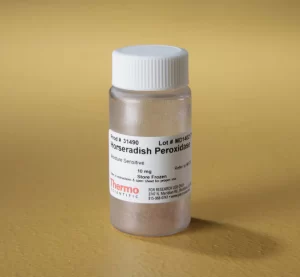
Thermo Scientific™ Pierce™ Horseradish Peroxidase X
$127.65 Add to cart View Product DetailsThermo Scientific™ Pierce Horseradish Peroxidase (HRP) is purified horseradish peroxidase enzyme for use in activity assays and conjugation to antibodies for ELISA, Western blotting and immunohistochemistry applications.
Highlights:
- Superior to alkaline phosphatase and β-galactosidase conjugates due to the higher specific enzyme activity
- Small size (40kDa) allows excellent cellular penetration
- Variety of substrates available
- Ideal in blotting and cytochemistry applications
- Used as the reporter enzyme for Thermo Scientific SuperSignal Chemiluminescent Western Blotting and ELISA Substrates
Note:
Porstmann, B., Porstmann, T., Nugel, E. and Evers, U. (1985). Which of the commonly used marker enzymes gives the best results in colorimetric and fluorimetric enzyme immunoassays: horseradish peroxidase, alkaline phosphatase, β-galactosidase, J. Immunol. Meth. 79, 27-37.
Wordinger, R.J., Miller, G.W. and Nicodemus, D.S. (1987). Manual of Immunoperoxidase Techniques, 2nd Edition. Chicago: American Society of Clinical Pathologists Press, pp. 23-24.
Yolken, R.H. (1982). Enzyme immunoassays for the detection of infectious antigens in body fluids: current limitations and future prospects. Rev. Infect. Dis. 4(1), 35-68.
Cordell, J.L., et al. (1984). Immunoenzymatic labeling of monoclonal antibodies using immune complexes of alkaline phosphatase and monoclonal anti-alkaline phosphatase (APAAP complexes). J. Histochem. Cytochem. 32, 219-229.
Passey, R.B., et al. (1977). Evaluation and comparison of 10 glucose methods and the reference method recommended in the proposed product class standard. Clin. Chem. 23(1), 131.
Hosoda, H., Takasaki, W., Tsukamoto, R. and Nambara, T. (1987). Sensitivity of steroid immunoassays. Comparison of alkaline phosphatase, β-galactosidase and horseradish peroxidase as labels in a colorimetric assay system. Chem. Pharm. Bull. 35, 3336-3342.
Samoszuk, M.K., et al. (1989). Antibody, Immunoconjugates and Radiopharmaceuticals 2, 37-46.
-

Thermo Scientific™ Pierce™ Horseradish Peroxidase X
$430.10 Add to cart View Product DetailsThermo Scientific™ Pierce Horseradish Peroxidase (HRP) is purified horseradish peroxidase enzyme for use in activity assays and conjugation to antibodies for ELISA, Western blotting and immunohistochemistry applications.
Highlights:
- Superior to alkaline phosphatase and β-galactosidase conjugates due to the higher specific enzyme activity
- Small size (40kDa) allows excellent cellular penetration
- Variety of substrates available
- Ideal in blotting and cytochemistry applications
- Used as the reporter enzyme for Thermo Scientific SuperSignal Chemiluminescent Western Blotting and ELISA Substrates
Note:
Porstmann, B., Porstmann, T., Nugel, E. and Evers, U. (1985). Which of the commonly used marker enzymes gives the best results in colorimetric and fluorimetric enzyme immunoassays: horseradish peroxidase, alkaline phosphatase, β-galactosidase, J. Immunol. Meth. 79, 27-37.
Wordinger, R.J., Miller, G.W. and Nicodemus, D.S. (1987). Manual of Immunoperoxidase Techniques, 2nd Edition. Chicago: American Society of Clinical Pathologists Press, pp. 23-24.
Yolken, R.H. (1982). Enzyme immunoassays for the detection of infectious antigens in body fluids: current limitations and future prospects. Rev. Infect. Dis. 4(1), 35-68.
Cordell, J.L., et al. (1984). Immunoenzymatic labeling of monoclonal antibodies using immune complexes of alkaline phosphatase and monoclonal anti-alkaline phosphatase (APAAP complexes). J. Histochem. Cytochem. 32, 219-229.
Passey, R.B., et al. (1977). Evaluation and comparison of 10 glucose methods and the reference method recommended in the proposed product class standard. Clin. Chem. 23(1), 131.
Hosoda, H., Takasaki, W., Tsukamoto, R. and Nambara, T. (1987). Sensitivity of steroid immunoassays. Comparison of alkaline phosphatase, β-galactosidase and horseradish peroxidase as labels in a colorimetric assay system. Chem. Pharm. Bull. 35, 3336-3342.
Samoszuk, M.K., et al. (1989). Antibody, Immunoconjugates and Radiopharmaceuticals 2, 37-46.
-
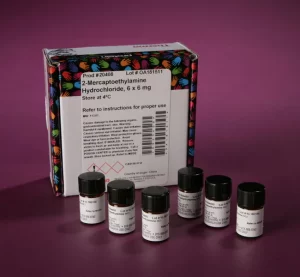
Thermo Scientific™ Pierce™ Mercaptoethylamine-HCl
$270.25 Add to cart View Product DetailsThermo Scientific™ Pierce 2-Mercaptoethylamine-HCl, commonly abbreviated 2-MEA, is a mild reductant that is often used to selectively reduce hinge-region disulfide bonds in antibody.
-
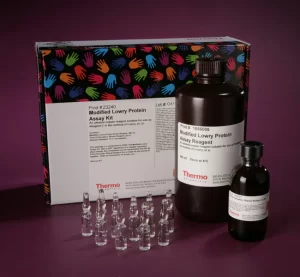
Thermo Scientific™ Pierce™ Modified Lowry Protein Assay Kit
$269.10 Add to cart View Product DetailsThermo Scientific™ Pierce Modified Lowry Protein Assay is a classical, well-characterized copper-based method for measuring protein concentration.
The Modified Lowry Protein Assay Kit combines a stabilized formulation of the original Lowry Reagents and the essential Folin-Ciocalteu Phenol reagent in a complete kit for accurately determining protein concentration in a variety of samples types. Although newer protein assay methods provide greater speed and convenience, the Lowry method remains a popular, accurate, and useful option for many applications.
Highlights:
- Popular method – widely cited in protein research literature
- Colorimetric – measure with a standard spectrophotometer or plate reader (750nm)
- Stable – uses a modified cupric sulfate-tartrate reagent that is stable at room temperature
- Large range – exhibits good linearity in the range 1 to 1500μg/mL (tested with BSA protein)
- Convenient – microplate and cuvet protocols provided with the instructions
Includes:
Modified Lowry Protein Assay Reagent, Folin-Ciocalteu Phenol Reagent (2N), and ampules of Albumin Standard (2mg/mL)
-
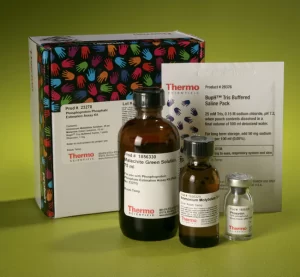
Thermo Scientific™ Pierce™ Phosphoprotein Phosphate Estimation Assay Kit
$713.00 Add to cart View Product DetailsThermo Scientific™ Phosphoprotein Phosphate Estimation Kit enables classification and identification of proteins as phosphorylated (serine and threonine), as well as semi-quantitative assessment of the phosphorylation level.
The Phosphoprotein Phosphate Estimation Assay Kit is designed to aid in characterization of the status and extent of phosphorylation of purified protein samples. The assay is based on the alkaline hydrolysis of phosphate from seryl and threonyl residues in phosphoproteins and quantification of the released phosphate with malachite green and ammonium molybdate. The assay is easily performed in 96-well microplates or test tubes and is completed in about one hour.
The assay can be used to identify whether a purified protein contains either phospho-serine (p-Ser) or phospho-threonine (p-Thr) as well as to estimate the level of this type of phosphorylation. For quantitation, the test protein sample is compared with specific concentrations of phosvitin, a phosphoprotein of known phosphorylation level. The alkaline hydrolysis step does not release phosphate from phospho-tyrosine (p-Tyr) residues in peptide linkage. Therefore, a negative result for an unknown purified protein preparation indicates that the protein is either (1) not a phosphoprotein or (2) is phosphorylated exclusively at tyrosine residues. In the latter case, Western blot analysis using an anti-phosphotyrosine antibody will be necessary to distinguish between these two possibilities.
Highlights:
- Specific – measures phosphoserine (p-Ser) and phosphothreonine (p-Thr) only; does not measure phosphotyrosine (p-Tyr)
- Convenient – test tube and 96-well microplate protocols included and require less than 90 minutes to perform
- Semi-quantitative – calculate moles of phosphate (P) per mole of protein using the included phosvitin standard
- Customizable – format is adaptable to development of specific assays for pure phosphoproteins when previously characterized standards are available
Includes:
Ammonium molybdate solution, malachite green solution, Tris-buffered saline pack and phopvitin positive control
Recommended for:
Identify proteins as containing phosphoserine or phosphothreonine phosphorylations; Estimate the amount of pS and pT phosphorylation; Develop specific quantitative assays for well-characterized phosphoproteins of interest
-
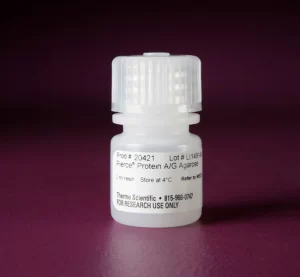
Thermo Scientific™ Pierce™ Protein A/G Agarose X
$657.80 Add to cart View Product DetailsThermo Scientific™ Pierce Protein A/G Agarose is a versatile, high-performance affinity resin for antibody purification that is available as bottled agarose beads, pre-packed spin columns, chromatography cartridges and complete IgG purification kits.
Pierce Protein A/G Agarose binds nearly all isotypes and mammalian species of IgG from serum, ascites fluid, cell culture supernantant and other antibody samples, thereby enabling effective antibody purification. Because the immobilized Protein A/G combines the immunoglobulin-binding domains of both Protein A and Protein G, the resin is effective for affinity purification of IgG antibodies from a broad range mammalian host species.
Pierce Protein A/G Agarose consists of purified Protein A/G recombinant fusion protein that has been covalently immobilized onto high-quality crosslinked 6% beaded agarose (CL-6B). This premiere variety of the resin provides the most versatile combination of chromatographic features for high yield and high purity purification of whole IgG from mammalian serum samples. The agarose beads have physical and chemical properties suitable for many affinity purification systems. Accordingly, Pierce Protein A/G Agarose is offered in several convenient package formats, including bottled resin slurries, three sizes of spin columns, complete purification kits, two sizes of FPLC-ready chromatography cartridges, and 96-well filter plates.
Highlights:
- Protein A/G – immobilized recombinant fusion protein of the antibody-binding domains of Protein A and Protein G enables polyclonal IgG purification from nearly any mammalian species
- Agarose resin – support is crosslinked 6% beaded agarose (CL-6B), the most popular resin for protein affinity purification methods
- Inert and stable – superior manufacturing method immobilizes Protein A/G by charge-free, leach-resistant covalent bonds, resulting in low nonspecific binding and enabling multiple uses without decline in yield
- Standard capacity – Pierce Protein A/G Agarose has a normal load of immobilized Protein A/G, providing a binding capacity greater than 7mg human IgG/mL resin
- Multiple formats – choose from bottled resin slurries, centrifuge-ready columns, complete purification kits and two sizes of FPLC-ready chromatography cartridges
Properties of crosslinked 6% beaded agarose (CL-6B):
- Support pH Stability: 2 to 14 (short term); 3 to 13 (long term)
- Average Particle Size: 45 to 165 microns
- Exclusion Limit: 10,000 to 4,000,000 daltons
- Maximum Volumetric Flow Rate: approx. 1mL/minute (for 1cm diameter column)
- Maximum Linear Velocity: 30cm per hour
- Maximum Pressure: less than 25psi (1.5 bar), defined as the maximum pressure drop across a column that the resin can withstand (Note: The indicated gauge pressure of a liquid chromatography apparatus may be measuring the total system pressure rather than the pressure drop across the column.)
Available Formats:
- Resin Slurries: 3mL and 15mL bottles
- Spin Columns: 0.2mL (microcentrifuge), 1mL, 5mL columns
- Purification Kits: complete kits in all three column sizes
- Chromatography Cartridges: compatible with automated liquid chromatography systems and with syringe processing
- Bulk and Custom: let us know your needs for bulk Pierce Protein A/G Agarose
Includes:
Purification kits contain Protein A/G Spin Columns, binding buffer, elution buffer and neutralization buffer.
-
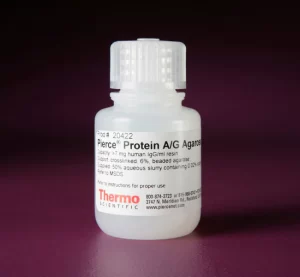
Thermo Scientific™ Pierce™ Protein A/G Agarose X
$2,300.00 Add to cart View Product DetailsThermo Scientific™ Pierce Protein A/G Agarose is a versatile, high-performance affinity resin for antibody purification that is available as bottled agarose beads, pre-packed spin columns, chromatography cartridges and complete IgG purification kits.
Pierce Protein A/G Agarose binds nearly all isotypes and mammalian species of IgG from serum, ascites fluid, cell culture supernantant and other antibody samples, thereby enabling effective antibody purification. Because the immobilized Protein A/G combines the immunoglobulin-binding domains of both Protein A and Protein G, the resin is effective for affinity purification of IgG antibodies from a broad range mammalian host species.
Pierce Protein A/G Agarose consists of purified Protein A/G recombinant fusion protein that has been covalently immobilized onto high-quality crosslinked 6% beaded agarose (CL-6B). This premiere variety of the resin provides the most versatile combination of chromatographic features for high yield and high purity purification of whole IgG from mammalian serum samples. The agarose beads have physical and chemical properties suitable for many affinity purification systems. Accordingly, Pierce Protein A/G Agarose is offered in several convenient package formats, including bottled resin slurries, three sizes of spin columns, complete purification kits, two sizes of FPLC-ready chromatography cartridges, and 96-well filter plates.
Highlights:
- Protein A/G – immobilized recombinant fusion protein of the antibody-binding domains of Protein A and Protein G enables polyclonal IgG purification from nearly any mammalian species
- Agarose resin – support is crosslinked 6% beaded agarose (CL-6B), the most popular resin for protein affinity purification methods
- Inert and stable – superior manufacturing method immobilizes Protein A/G by charge-free, leach-resistant covalent bonds, resulting in low nonspecific binding and enabling multiple uses without decline in yield
- Standard capacity – Pierce Protein A/G Agarose has a normal load of immobilized Protein A/G, providing a binding capacity greater than 7mg human IgG/mL resin
- Multiple formats – choose from bottled resin slurries, centrifuge-ready columns, complete purification kits and two sizes of FPLC-ready chromatography cartridges
Properties of crosslinked 6% beaded agarose (CL-6B):
- Support pH Stability: 2 to 14 (short term); 3 to 13 (long term)
- Average Particle Size: 45 to 165 microns
- Exclusion Limit: 10,000 to 4,000,000 daltons
- Maximum Volumetric Flow Rate: approx. 1mL/minute (for 1cm diameter column)
- Maximum Linear Velocity: 30cm per hour
- Maximum Pressure: less than 25psi (1.5 bar), defined as the maximum pressure drop across a column that the resin can withstand (Note: The indicated gauge pressure of a liquid chromatography apparatus may be measuring the total system pressure rather than the pressure drop across the column.)
Available Formats:
- Resin Slurries: 3mL and 15mL bottles
- Spin Columns: 0.2mL (microcentrifuge), 1mL, 5mL columns
- Purification Kits: complete kits in all three column sizes
- Chromatography Cartridges: compatible with automated liquid chromatography systems and with syringe processing
- Bulk and Custom: let us know your needs for bulk Pierce Protein A/G Agarose
Includes:
Purification kits contain Protein A/G Spin Columns, binding buffer, elution buffer and neutralization buffer
-

Thermo Scientific™ Pierce™ Protein A/G Plus Agarose X
$660.10 Add to cart View Product DetailsHighlights:
- Protein A/G – immobilized recombinant fusion protein of the antibody-binding domains of Protein A and Protein G enables polyclonal IgG purification from nearly any mammalian species
- Agarose resin – support is crosslinked 6% beaded agarose (CL-6B), the most popular resin for protein affinity purification methods
- Inert and stable – superior manufacturing method immobilizes Protein A/G by charge-free, leach-resistant covalent bonds, resulting in low nonspecific binding and enabling multiple uses without decline in yield
- High capacity – “Plus” variety of Pierce Protein A/G Agarose has a very dense load of immobilized Protein A/G, providing a binding capacity greater than 50mg human IgG/mL resin
Properties of crosslinked 6% beaded agarose (CL-6B):
- Support pH Stability: 2 to 14 (short term); 3 to 13 (long term)
- Average Particle Size: 45 to 165 microns
- Exclusion Limit: 10,000 to 4,000,000 daltons
- Maximum Volumetric Flow Rate: approx. 1mL/minute (for 1cm diameter column)
- Maximum Linear Velocity: 30cm per hour
- Maximum Pressure: less than 25psi (1.5 bar), defined as the maximum pressure drop across a column that the resin can withstand (Note: The indicated gauge pressure of a liquid chromatography apparatus may be measuring the total system pressure rather than the pressure drop across the column.)
-
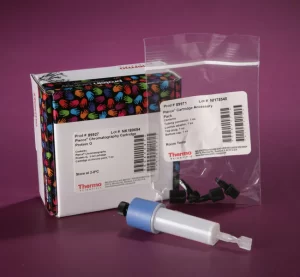
Thermo Scientific™ Pierce™ Protein G Chromatography Cartridges, 1 mL
$742.90 Add to cart View Product DetailsThermo Scientific™ Pierce Protein G Agarose is a versatile, high-performance affinity resin for antibody purification that is available as bottled agarose beads, pre-packed spin columns, 96-well filter plates and complete IgG purification kits.
Pierce Protein G Agarose is effective for affinity purification of IgG from serum and other fluids of many mammalian species. Protein G is especially well suited for use with mouse antibodies (including IgG1) in addition to most IgG isotypes from human, goat and sheep samples.
Pierce Protein G Agarose consists of recombinant Protein G that has been covalently immobilized onto high-quality crosslinked 6% beaded agarose (CL-6B). This premiere variety of the affinity resin provides the most versatile combination of chromatographic features for high yield and high purity purification of whole IgG from mammalian serum samples. The agarose beads have physical and chemical properties suitable for many affinity purification systems. Accordingly, Pierce Protein G Agarose is offered in several convenient package formats, including bottled resin slurries, three sizes of spin columns, complete purification kits, two sizes of FPLC-ready chromatography cartridges, and 96-well filter plates.
Highlights:
- Protein G – immobilized Protein G is ideal for polyclonal IgG purification from mouse, human, cow, goat and sheep serum, including human IgG3 and mouse IgG1 isotypes
- Agarose resin – support is crosslinked 6% beaded agarose (CL-6B), the most popular resin for protein affinity purification methods
- Inert and stable – superior manufacturing method immobilizes Protein G by charge-free, leach-resistant covalent bonds, resulting in low nonspecific binding and enabling multiple uses without decline in yield
- Standard capacity – Pierce Protein G Agarose has a normal load of immobilized Protein G, providing a binding capacity of 11 to 15mg human IgG/mL resin
- Multiple formats – choose from bottled resin slurries, centrifuge-ready columns, complete purification kits, two sizes of FPLC-ready chromatography cartridges, and 96-well filter plates
Properties of crosslinked 6% beaded agarose (CL-6B):
- Support pH Stability: 2 to 14 (short term); 3 to 13 (long term)
- Average Particle Size: 45 to 165 microns
- Exclusion Limit: 10,000 to 4,000,000 daltons
- Maximum Volumetric Flow Rate: approx. 1mL/minute (for 1cm diameter column)
- Maximum Linear Velocity: 30cm per hour
- Maximum Pressure: less than 25psi (1.5 bar), defined as the maximum pressure drop across a column that the resin can withstand (Note: The indicated gauge pressure of a liquid chromatography apparatus may be measuring the total system pressure rather than the pressure drop across the column.)
Available Formats:
- Resin Slurries: 2mL, 10mL, 25mL bottles
- Spin Columns: 0.2mL (microcentrifuge), 1mL, 5mL columns
- Purification Kits: complete kits in all three column sizes
- Chromatography Cartridges: compatible with automated liquid chromatography systems and with syringe processing
- 96-well Spin Plates: pre-dispensed 96-well filter plates, compatible with centrifugation and vacuum manifold systems for manual or automated purification. The plates enable fast, consistent well-to-well and plate-to-plate reproducibility for small-scale, high-throughput separations.
- Bulk and Custom: let us know your needs for bulk Pierce Protein G Agarose
Includes:
Purification kits contain Protein G Spin Columns, binding buffer, elution buffer and neutralization buffer
-

Thermo Scientific™ Pierce™ Protein G Chromatography Cartridges, 1 mL
$366.85 Add to cart View Product DetailsThermo Scientific™ Pierce Protein G Agarose is a versatile, high-performance affinity resin for antibody purification that is available as bottled agarose beads, pre-packed spin columns, 96-well filter plates and complete IgG purification kits.
Pierce Protein G Agarose is effective for affinity purification of IgG from serum and other fluids of many mammalian species. Protein G is especially well suited for use with mouse antibodies (including IgG1) in addition to most IgG isotypes from human, goat and sheep samples.
Pierce Protein G Agarose consists of recombinant Protein G that has been covalently immobilized onto high-quality crosslinked 6% beaded agarose (CL-6B). This premiere variety of the affinity resin provides the most versatile combination of chromatographic features for high yield and high purity purification of whole IgG from mammalian serum samples. The agarose beads have physical and chemical properties suitable for many affinity purification systems. Accordingly, Pierce Protein G Agarose is offered in several convenient package formats, including bottled resin slurries, three sizes of spin columns, complete purification kits, two sizes of FPLC-ready chromatography cartridges, and 96-well filter plates.
Highlights:
- Protein G – immobilized Protein G is ideal for polyclonal IgG purification from mouse, human, cow, goat and sheep serum, including human IgG3 and mouse IgG1 isotypes
- Agarose resin – support is crosslinked 6% beaded agarose (CL-6B), the most popular resin for protein affinity purification methods
- Inert and stable – superior manufacturing method immobilizes Protein G by charge-free, leach-resistant covalent bonds, resulting in low nonspecific binding and enabling multiple uses without decline in yield
- Standard capacity – Pierce Protein G Agarose has a normal load of immobilized Protein G, providing a binding capacity of 11 to 15mg human IgG/mL resin
- Multiple formats – choose from bottled resin slurries, centrifuge-ready columns, complete purification kits, two sizes of FPLC-ready chromatography cartridges, and 96-well filter plates
Properties of crosslinked 6% beaded agarose (CL-6B):
- Support pH Stability: 2 to 14 (short term); 3 to 13 (long term)
- Average Particle Size: 45 to 165 microns
- Exclusion Limit: 10,000 to 4,000,000 daltons
- Maximum Volumetric Flow Rate: approx. 1mL/minute (for 1cm diameter column)
- Maximum Linear Velocity: 30cm per hour
- Maximum Pressure: less than 25psi (1.5 bar), defined as the maximum pressure drop across a column that the resin can withstand (Note: The indicated gauge pressure of a liquid chromatography apparatus may be measuring the total system pressure rather than the pressure drop across the column.)
Available Formats:
- Resin Slurries: 2mL, 10mL, 25mL bottles
- Spin Columns: 0.2mL (microcentrifuge), 1mL, 5mL columns
- Purification Kits: complete kits in all three column sizes
- Chromatography Cartridges: compatible with automated liquid chromatography systems and with syringe processing
- 96-well Spin Plates: pre-dispensed 96-well filter plates, compatible with centrifugation and vacuum manifold systems for manual or automated purification. The plates enable fast, consistent well-to-well and plate-to-plate reproducibility for small-scale, high-throughput separations.
- Bulk and Custom: let us know your needs for bulk Pierce Protein G Agarose
Includes:
Purification kits contain Protein G Spin Columns, binding buffer, elution buffer and neutralization buffer
-
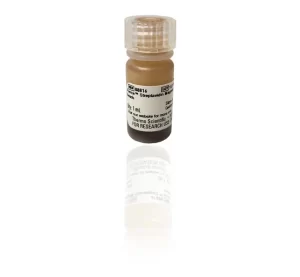
Thermo Scientific™ Pierce™ Streptavidin Magnetic Beads
$458.85 Add to cart View Product DetailsAccelerate throughput for automated magnetic purification of biotinylated molecules with Thermo Scientific™ Pierce Streptavidin Magnetic Beads.
Magnetic streptavidin beads enable affinity purification of biotin-labeled target molecules without columns or centrifugation. The platform provides a fast and convenient method for manual or automated immunoprecipitation, protein interaction analysis, DNA-protein pull-down, and purification involving biotin-labeled proteins and nucleic acids. The iron oxide superparamagnetic particles offer superior performance (high capacity and low nonspecific binding) compared with other commercial magnetic beads. Biotinylated molecules are simply added to the streptavidin-coated magnetic beads for binding. Pierce Streptavidin Magnetic Beads are validated and optimized for use with high-throughput magnetic platforms, such as the Thermo Scientific KingFisher™ 96 and KingFisher Flex Instruments, but the beads also enable premium performance for simple benchtop applications using an appropriate magnetic stand.
Highlights:
- High-performance beads – non-aggregating, pre-blocked, iron oxide, superparamagnetic microparticles provide exceptional uniformity for automated HTS and manual applications alike
- Stable immobilization chemistry – streptavidin is immobilized using leach-resistant chemistry
- High capacity – superior quality beads with high binding capacity provide rapid and efficient biomolecule purification from complex samples
- Low non-specific binding – stable, pre-blocked beads provide clean purification products (e.g., antigen eluted in IP with biotinylated antibody) that are compatible with mass spectrometry analysis and other downstream analyses
- Superior performance – nearly three times higher binding capacity than typical beads from other suppliers, allowing the use of smaller amounts per experiment
Properties of Streptavidin Magnetic Beads:
- Composition: ion oxide particles covalently coated with a monolayer of streptavidin protein
- Magnetization: superparamagnetic (no magnetic memory)
- Bead size: 1μm (nominal mean diameter)
- Density: 2g/cm3
- Concentration: 10mg beads per milliliter of slurry in 0.05% sodium azide
- Binding capacity: approx. 55μg biotinylated rabbit IgG per mg of beads; approx. 3500pmol biotinylated fluorescein per milliliter of beads
- RNase: these bead solutions are NOT tested and certified to be RNAse-free
Requires:
Thermo Scientific KingFisher 96 or KingFisher Flex Instrument or other magnetic separator device
Recommended for:
Immunoprecipitate antigens (using biotinylated antibodies) from a wide variety of sources; Co-immunoprecipitate interaction complexes using biotinylated antibodies; Capture protein-protein interactions in pull-down assays using biotinylated bait proteins; Isolate biotin-labeled DNA-protein complexes from cell or tissue extracts; Capture single-stranded biotinylated DNA oligos; Isolate biotinylated PCR products
-
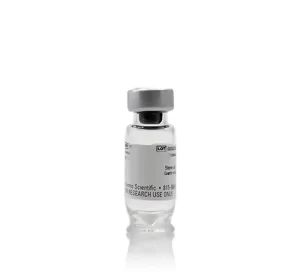
Thermo Scientific™ Pierce™ Streptavidin, Maleimide-Activated
$285.20 Add to cart View Product DetailsThermo Scientific™ Pierce Streptavidin and Conjugates include purified recombinant streptavidin biotin-binding protein, plus standard SA-HRP, SA-AP and fluorescent conjugates for biotin-based assays.
These purified and conjugated forms of recombinant streptavidin protein enable detection of biotinylated antibodies and other probes in a variety of standard assay methods, including Western blotting, ELISA, immunohistochemistry and fluorescence imaging. Purified streptavidin and the streptavidin-HRP conjugates (peroxidase-conjugated streptavidin) are supplied lyophilized in phosphate-based buffers for immediate reconstitution with water. Alkaline Phosphatase conjugates are supplied as a liquid in a Tris-based buffer.
Highlights:
- Recombinant streptavidin – high-quality protein, 53kDa, pI equals 6.8 to 7.5
- Pure protein and enzyme conjugates – choose pure, unconjugated protein for biotin blocking and controls; enzyme conjugates for substrate-based detection
- Fluorophore conjugates – standard fluorescent forms (fluorescein, rhodamine, etc.) for traditional immunofluorescence techniques
- Activated preparations – choose a maleimide-activated or hydrazide-activated form to prepare a custom streptavidin conjugate with sulfhydryl- or carbohydrate-containing molecule
-
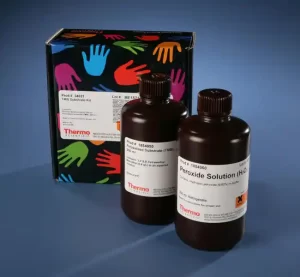
Thermo Scientific™ Pierce™ TMB Substrate Kit SKU: 34021
$240.35 Add to cart View Product DetailsThermo Scientific™ Pierce TMB ELISA Substrates detect horseradish peroxidase (HRP) activity, yielding a blue color (Amax = 370nm and 652nm) that changes to yellow (Amax = 450nm) upon addition of a sulfuric or phosphoric acid stop solution.
nTMB (3,3′,5,5′ tetramethylbenzidine) is a chromagen that yields a blue color when oxidized with hydrogen peroxide (catalyzed by HRP) with major absorbances at 370 and 652nm. The color then changes to yellow (measured at 450nm) upon addition of sulfuric or phosphoric acid to stop the reaction. TMB is very sensitive and more quickly oxidized than other HRP substrates, resulting in faster color development. Unlike other commercially available substrates, these products contain no DMF or DMSO. There are three formulations that differ primarily in their sensitivities. Slow TMB is intermediate in sensitivity, ideal for kinetic readings. The sensitivity of the Turbo TMB compares to that of OPD used at approximately 1mg/mL. Ultra TMB-ELISA produces the highest signal-to-noise ratio and sensitivity in the picogram range.nnHighlights:n
-
- n
- Ready-to-use solutions
n
-
- No hydrogen peroxide required
n
-
- No filtering required
n
-
- Noncarcinogenic
n
-
- Various sensitivities to suit any assay
n
n1-Step TMB Substratesn
-
- n
- Ready-to-use, one-component substrates
n
-
- Do not require hydrogen peroxide
n
-
- Noncarcinogenic
n
-
- Do not contain DMF or DMSO
n
-
- Available in three formulations that vary by sensitivity
n
nTMB Substrate Kitn
-
- n
- More sensitive than OPD in endpoint ELISAs
n
-
- Easy to use
n
-
- Provides results in seconds
n
nIncludes:nnTMB Substrate Kit (PI-34021): Peroxidase substrate, 200mL; Peroxide solution, 200mL
-
-
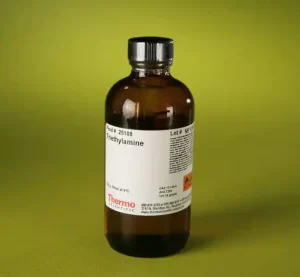
Thermo Scientific™ Pierce™ Triethylamine (TEA), Sequencing Grade
$204.70 Add to cart View Product DetailsThermo Scientific™ Pierce Triethylamine (TEA) is a high-purity solvent that can be used in certain HPLC protocols, such as weak anion exchange to resolve certain tryptic peptides on a reverse-phase column.
nTriethylamine is an ion-pairing reagent that alters selectivity in reverse-phase HPLC separations. By pairing with peptides, it effectively sharpens peaks, resulting in improved peak resolution.
-
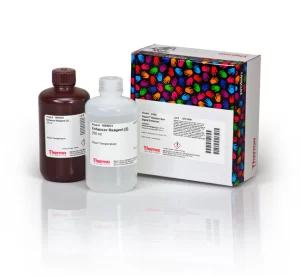
Thermo Scientific™ Pierce™ Western Blot Signal Enhancer
$231.15 Add to cart View Product DetailsThermo Scientific™ Pierce Western Blot Signal Enhancer is a two-reagent system for conditioning protein blots after transfer to greatly enhance the effectiveness of primary antibodies and intensify the final detection signal in Western blot experiments.
The Pierce Western Blot Signal Enhancer membrane treatment procedure is very simple, takes only 15 minutes and can be added to nearly any existing Western blotting protocol. The result is an increase in the intensity of target protein bands on the Western blot or detection of target proteins at levels that were previously not possible. The product is effective for signal intensification with both chemiluminescent and chromogenic substrates, especially with nitrocellulose membranes.
Highlights:
- Increases protein detection – most protein targets show a three- to 10-fold increase in signal intensity, enabling much less protein to be detected with the same substrate and method
- Improves antibody binding – the membrane-treatment reagent exposes and conditions target proteins so that specific antibodies can bind more effectively
- Works for nearly any protein – signal enhancement has been demonstrated with targets such as IL-6, p53, NFkB, BRCA1 and EGF
- Effective with any substrate – enhances both chemiluminescent (ECL) and colorimetric detection for Western blots
- Compatible with any membrane – enhances signal on nitrocellulose and PVDF membrane, regardless of pore size (enhancement is less pronounced with PVDF)
- Fast, 15-minute protocol – optimized for a combination of simplicity, speed and signal enhancement for most proteins
- Ready-to-use – no formulating or diluting necessary, and the reagents are stable for storage at room temperature
Includes:
Enhancer Reagent 1, 250mL; Enhancer Reagent 2, 250mL
-
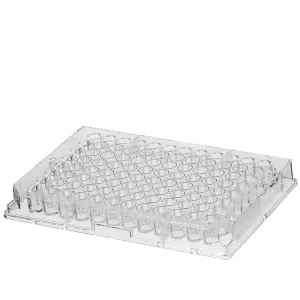
Thermo Scientific™ Plates and Modules with Affinity Binding Surfaces
$1,023.81 Add to cart View Product DetailsHelp reduce variability in molecular orientation with Thermo Scientific™ Plates and Modules with Affinity Binding Surfaces.
Affinity Capture Surfaces (Passive Streptavidin and Immobilizer Streptavidin, Nickel Chelate and Glutathione, BioBind)
-
- Highly specific binding
n
-
- Reduced variability in molecular orientation
n
-
- Immobilizer surfaces improve signal to noise ratios
n
-
- Streptavidin biotin interaction can be exploited to immobilize a wide range of biomolecules
n
-
-
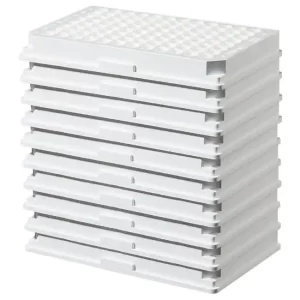
Thermo Scientific™ Plates and Modules with Affinity Binding Surfaces
$1,036.44 Add to cart View Product DetailsHelp reduce variability in molecular orientation with Thermo Scientific™ Plates and Modules with Affinity Binding Surfaces.
Affinity Capture Surfaces (Passive Streptavidin and Immobilizer Streptavidin, Nickel Chelate and Glutathione, BioBind)
-
- Highly specific binding
n
-
- Reduced variability in molecular orientation
n
-
- Immobilizer surfaces improve signal to noise ratios
n
-
- Streptavidin biotin interaction can be exploited to immobilize a wide range of biomolecules
n
-
-
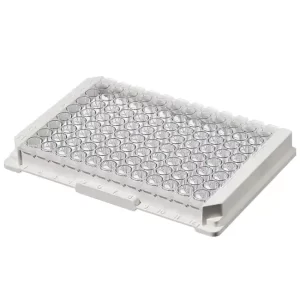
Thermo Scientific™ Plates and Modules with Affinity Binding Surfaces
$1,092.86 Add to cart View Product DetailsHelp reduce variability in molecular orientation with Thermo Scientific™ Plates and Modules with Affinity Binding Surfaces.
Affinity Capture Surfaces (Passive Streptavidin and Immobilizer Streptavidin, Nickel Chelate and Glutathione, BioBind)
-
- Highly specific binding
n
-
- Reduced variability in molecular orientation
n
-
- Immobilizer surfaces improve signal to noise ratios
n
-
- Streptavidin biotin interaction can be exploited to immobilize a wide range of biomolecules
n
-
-

Thermo Scientific™ Plates and Modules with Covalent Binding Surfaces
$1,032.18 Add to cart View Product DetailsReduce the amount of reagents used in the lab with Thermo Scientific™ Plates and Modules with Covalent Binding Surfaces. Covalent Surfaces (Thermo Scientific™ CovaLink™ and Immobilizer Amino)
-
- Minimal leaching
n
-
- Withstands vigorous washing
n
-
- Coating with lower amounts of reagent may be possible
n
-
- Control of orientation
n
-
-
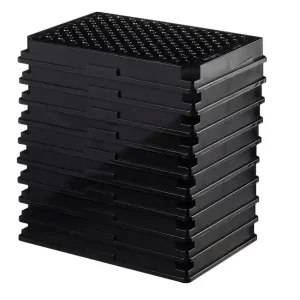
Thermo Scientific™ Plates and Modules with Covalent Binding Surfaces
$1,129.52 Add to cart View Product DetailsReduce the amount of reagents used in the lab with Thermo Scientific™ Plates and Modules with Covalent Binding Surfaces.
Covalent Surfaces (Thermo Scientific™ CovaLink™ and Immobilizer Amino)
-
- Minimal leaching
n
-
- Withstands vigorous washing
n
-
- Coating with lower amounts of reagent may be possible
n
-
- Control of orientation
n
-
-
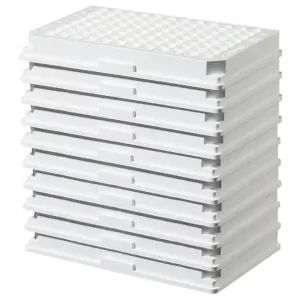
Thermo Scientific™ Plates and Modules with Covalent Binding Surfaces
$1,137.96 Add to cart View Product DetailsReduce the amount of reagents used in the lab with Thermo Scientific™ Plates and Modules with Covalent Binding Surfaces.
Covalent Surfaces (Thermo Scientific™ CovaLink™ and Immobilizer Amino)
-
- Minimal leaching
n
-
- Withstands vigorous washing
n
-
- Coating with lower amounts of reagent may be possible
n
-
- Control of orientation
n
-
-
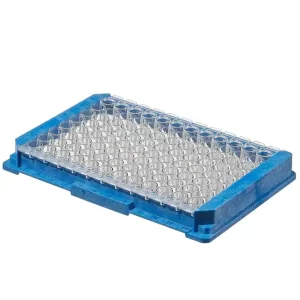
Thermo Scientific™ Plates and Modules with Covalent Binding Surfaces
$937.18 Add to cart View Product DetailsReduce the amount of reagents used in the lab with Thermo Scientific™ Plates and Modules with Covalent Binding Surfaces.
Covalent Surfaces (Thermo Scientific™ CovaLink™ and Immobilizer Amino)
-
- Minimal leaching
n
-
- Withstands vigorous washing
n
-
- Coating with lower amounts of reagent may be possible
n
-
- Control of orientation
n
-
-

Thermo Scientific™ Plates and Modules with Covalent Binding Surfaces
$1,092.59 Add to cart View Product DetailsReduce the amount of reagents used in the lab with Thermo Scientific™ Plates and Modules with Covalent Binding Surfaces.nn nnCovalent Surfaces (Thermo Scientific™ CovaLink™ and Immobilizer Amino)n
-
- Minimal leaching
n
-
- Withstands vigorous washing
n
-
- Coating with lower amounts of reagent may be possible
n
-
- Control of orientation
n
Immobilizer is a trademark of Exiqon A/S, Vedbaek, Denmark. The product is produced under license from Exiqon A/S and covered by EP 08 20483 and foreign application and patents.
-
-
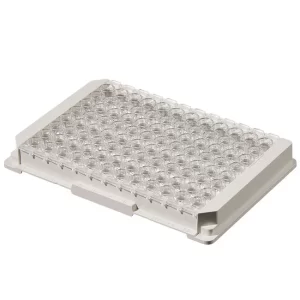
Thermo Scientific™ Plates and Modules with Covalent Binding Surfaces
$1,092.59 Add to cart View Product DetailsReduce the amount of reagents used in the lab with Thermo Scientific™ Plates and Modules with Covalent Binding Surfaces.
Covalent Surfaces (Thermo Scientific™ CovaLink™ and Immobilizer Amino)
- Minimal leaching
- Withstands vigorous washing
- Coating with lower amounts of reagent may be possible
- Control of orientation
Immobilizer is a trademark of Exiqon A/S, Vedbaek, Denmark. The product is produced under license from Exiqon A/S and covered by EP 08 20483 and foreign application and patents.
-
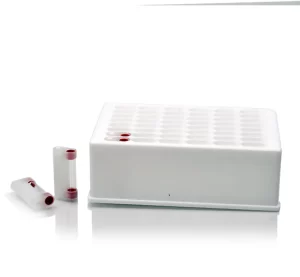
Thermo Scientific™ Rapid Equilibrium Dialysis (RED) Inserts and Plates
$64.40 Add to cart View Product DetailsRapid Equilibrium Dialysis (RED) Devices have been widely adopted as an effective in vitro technique for conducting plasma protein binding (PPB) assays in drug development. This measurement is used to assess the biological availability of drug candidates and guides critical downstream decisions such as drug design, in vivo testing prioritization, and drug-drug interaction evaluation. RED Devices were developed through close collaboration with the pharmaceutical industry, ensuring that they meet the highest standards of accuracy and reliability in equilibrium dialysis testing.
Equilibrium dialysis is commonly used in drug-plasma protein binding (PPB) studies to quantitate the free fraction of drugs in plasma. The binding of drugs to plasma proteins is a critical factor that affects their pharmacokinetics and pharmacodynamics, as only the free fraction of a drug can exert a physiological effect. The Thermo Scientific Pierce Rapid Equilibrium Dialysis (RED) Device is a superior method for conducting this analysis because it delivers accurate and consistent data with shorter preparation and dialysis times.
RED Devices use a size-defined dialysis membrane to quantitate the amount of free (active) drug molecules that are not bound to plasma proteins. They consist of disposable inserts and a base plate with a standard microplate footprint. The inserts are made of two side-by-side chambers separated by a dialysis membrane and are used along with a required base plate or are available as single-use plates with Inserts. Competition RED Devices are also available to enable competitive dialysis experiments with multiple tissue or protein fluid samples.
Features of RED Devices include:
• Ease of use—disposable tubes do not require presoaking, assembly, or specialized equipment
• Rapid dialysis—high surface-to-volume ratio of the membrane enables equilibrium in 2–4 hours
• High-throughput—96-well footprint is suitable for automation
• Multi-sample processing—can be used for 1–48 assays/plate without wasting an entire plate
• Robustness—compartmentalized design eliminates the potential for cross-contamination or leakage
• Reproducibility and accuracy—validated for plasma protein binding assays, producing results consistent with those reported in the literature
• Flexible format—available in pre-inserted disposable polypropylene plates and packs of individual insertsIn addition to plasma protein binding, the device is used for determining drug partitioning between red blood cells and plasma, protein binding of liver microsomes to improve the correlation between in vitro and in vivo intrinsic clearance, drug metabolism and pharmacokinetics (DMPK) assays, and competition between tissue protein binding against plasma proteins.
RED Device Inserts, 8K MWCO
Pierce RED Device Inserts are designed for use with a required base plate for equilibrium dialysis experiments. Each single-use, disposable insert is made of two side-by-side chambers separated by an O-ring-sealed vertical cylinder of dialysis membrane (8K MWCO) validated for minimal nonspecific binding. They are available in packs of 50 or 250 each and are useful for testing a variable number of samples per run.RED Device Base Plates
Pierce RED Device Inserts are used with either the RED Device Reusable Base Plate made of high-grade PTFE (Teflon™) or the RED Device Single-Use Base Plate made of high-density polypropylene. The Single-Use Base Plate is disposable and lightweight, allowing routine automation. Each Base Plate holds up to 48 RED Device Inserts and has a standard 96-well plate footprint with 9 x 9 mm well spacing for compatibility with multichannel pipettors and automated liquid handling systems.RED Device Single-Use Plate with Inserts, 8K or 12K MWCO
The RED Device Single-Use Plate with Inserts is composed of disposable high-density polypropylene and comes preloaded with 48 equilibrium dialysis membrane inserts. Each insert includes two side-by-side chambers separated by an O ring sealed vertical cylinder of dialysis membrane (8K or 12K MWCO). The device is automation-friendly and has a standard 96-well plate footprint with 9 x 9 mm well spacing. The single-use plate is easily disposed of to avoid contamination and cleaning, making it useful when performing PPB assays with radioactive or hazardous materials.Competition RED Device Inserts and Base Plate, 12K MWCO
The Pierce Competition RED Device facilitates the analysis of simultaneous drug interactions and partitioning among multiple tissues to accurately model in vivo drug interactions. The system consists of disposable dialysis tube inserts (12K MWCO) and a reusable base plate made of chemically inert high-grade PTFE, eliminating non-specific binding and risk of contamination. The base plate is divided into different size chambers for positioning 2–8 RED Device Inserts per well, enabling competitive dialysis experiments with 2–15 separate tissue or protein fluid samples. Each Competition RED Insert contains either one or two separate dialysis chambers (each package includes both types).Applications of the Competition RED Devices include:
• ADME-Tox studies: in vitro screening of drug partitioning between plasma and multiple tissues before in vivo studies with animal models
• Determine formulation of drug dosage for in vivo studies
• Drug-drug interaction studies
• Competitive binding and dissociation constant determination for small molecules versus multiple targetsRED Device Insert Removal Tool
This tool enables fast removal of 8 inserts at once. -

Thermo Scientific™ Rapid Equilibrium Dialysis (RED) Inserts and Plates
$273.70 Add to cart View Product DetailsRapid Equilibrium Dialysis (RED) Devices have been widely adopted as an effective in vitro technique for conducting plasma protein binding (PPB) assays in drug development. This measurement is used to assess the biological availability of drug candidates and guides critical downstream decisions such as drug design, in vivo testing prioritization, and drug-drug interaction evaluation. RED Devices were developed through close collaboration with the pharmaceutical industry, ensuring that they meet the highest standards of accuracy and reliability in equilibrium dialysis testing.
Equilibrium dialysis is commonly used in drug-plasma protein binding (PPB) studies to quantitate the free fraction of drugs in plasma. The binding of drugs to plasma proteins is a critical factor that affects their pharmacokinetics and pharmacodynamics, as only the free fraction of a drug can exert a physiological effect. The Thermo Scientific Pierce Rapid Equilibrium Dialysis (RED) Device is a superior method for conducting this analysis because it delivers accurate and consistent data with shorter preparation and dialysis times.
RED Devices use a size-defined dialysis membrane to quantitate the amount of free (active) drug molecules that are not bound to plasma proteins. They consist of disposable inserts and a base plate with a standard microplate footprint. The inserts are made of two side-by-side chambers separated by a dialysis membrane and are used along with a required base plate or are available as single-use plates with Inserts. Competition RED Devices are also available to enable competitive dialysis experiments with multiple tissue or protein fluid samples.
Features of RED Devices include:
• Ease of use—disposable tubes do not require presoaking, assembly, or specialized equipment
• Rapid dialysis—high surface-to-volume ratio of the membrane enables equilibrium in 2–4 hours
• High-throughput—96-well footprint is suitable for automation
• Multi-sample processing—can be used for 1–48 assays/plate without wasting an entire plate
• Robustness—compartmentalized design eliminates the potential for cross-contamination or leakage
• Reproducibility and accuracy—validated for plasma protein binding assays, producing results consistent with those reported in the literature
• Flexible format—available in pre-inserted disposable polypropylene plates and packs of individual insertsIn addition to plasma protein binding, the device is used for determining drug partitioning between red blood cells and plasma, protein binding of liver microsomes to improve the correlation between in vitro and in vivo intrinsic clearance, drug metabolism and pharmacokinetics (DMPK) assays, and competition between tissue protein binding against plasma proteins.
RED Device Inserts, 8K MWCO
Pierce RED Device Inserts are designed for use with a required base plate for equilibrium dialysis experiments. Each single-use, disposable insert is made of two side-by-side chambers separated by an O-ring-sealed vertical cylinder of dialysis membrane (8K MWCO) validated for minimal nonspecific binding. They are available in packs of 50 or 250 each and are useful for testing a variable number of samples per run.RED Device Base Plates
Pierce RED Device Inserts are used with either the RED Device Reusable Base Plate made of high-grade PTFE (Teflon™) or the RED Device Single-Use Base Plate made of high-density polypropylene. The Single-Use Base Plate is disposable and lightweight, allowing routine automation. Each Base Plate holds up to 48 RED Device Inserts and has a standard 96-well plate footprint with 9 x 9 mm well spacing for compatibility with multichannel pipettors and automated liquid handling systems.RED Device Single-Use Plate with Inserts, 8K or 12K MWCO
The RED Device Single-Use Plate with Inserts is composed of disposable high-density polypropylene and comes preloaded with 48 equilibrium dialysis membrane inserts. Each insert includes two side-by-side chambers separated by an O ring sealed vertical cylinder of dialysis membrane (8K or 12K MWCO). The device is automation-friendly and has a standard 96-well plate footprint with 9 x 9 mm well spacing. The single-use plate is easily disposed of to avoid contamination and cleaning, making it useful when performing PPB assays with radioactive or hazardous materials.Competition RED Device Inserts and Base Plate, 12K MWCO
The Pierce Competition RED Device facilitates the analysis of simultaneous drug interactions and partitioning among multiple tissues to accurately model in vivo drug interactions. The system consists of disposable dialysis tube inserts (12K MWCO) and a reusable base plate made of chemically inert high-grade PTFE, eliminating non-specific binding and risk of contamination. The base plate is divided into different size chambers for positioning 2–8 RED Device Inserts per well, enabling competitive dialysis experiments with 2–15 separate tissue or protein fluid samples. Each Competition RED Insert contains either one or two separate dialysis chambers (each package includes both types).Applications of the Competition RED Devices include:
• ADME-Tox studies: in vitro screening of drug partitioning between plasma and multiple tissues before in vivo studies with animal models
• Determine formulation of drug dosage for in vivo studies
• Drug-drug interaction studies
• Competitive binding and dissociation constant determination for small molecules versus multiple targets -
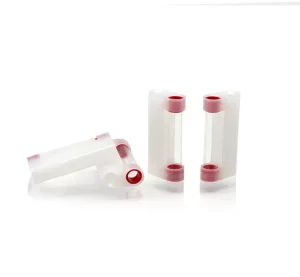
Thermo Scientific™ Rapid Equilibrium Dialysis (RED) Inserts and Plates
$2,846.25 Add to cart View Product DetailsRapid Equilibrium Dialysis (RED) Devices have been widely adopted as an effective in vitro technique for conducting plasma protein binding (PPB) assays in drug development. This measurement is used to assess the biological availability of drug candidates and guides critical downstream decisions such as drug design, in vivo testing prioritization, and drug-drug interaction evaluation. RED Devices were developed through close collaboration with the pharmaceutical industry, ensuring that they meet the highest standards of accuracy and reliability in equilibrium dialysis testing.
Equilibrium dialysis is commonly used in drug-plasma protein binding (PPB) studies to quantitate the free fraction of drugs in plasma. The binding of drugs to plasma proteins is a critical factor that affects their pharmacokinetics and pharmacodynamics, as only the free fraction of a drug can exert a physiological effect. The Thermo Scientific Pierce Rapid Equilibrium Dialysis (RED) Device is a superior method for conducting this analysis because it delivers accurate and consistent data with shorter preparation and dialysis times.
RED Devices use a size-defined dialysis membrane to quantitate the amount of free (active) drug molecules that are not bound to plasma proteins. They consist of disposable inserts and a base plate with a standard microplate footprint. The inserts are made of two side-by-side chambers separated by a dialysis membrane and are used along with a required base plate or are available as single-use plates with Inserts. Competition RED Devices are also available to enable competitive dialysis experiments with multiple tissue or protein fluid samples.
Features of RED Devices include:
• Ease of use—disposable tubes do not require presoaking, assembly, or specialized equipment
• Rapid dialysis—high surface-to-volume ratio of the membrane enables equilibrium in 2–4 hours
• High-throughput—96-well footprint is suitable for automation
• Multi-sample processing—can be used for 1–48 assays/plate without wasting an entire plate
• Robustness—compartmentalized design eliminates the potential for cross-contamination or leakage
• Reproducibility and accuracy—validated for plasma protein binding assays, producing results consistent with those reported in the literature
• Flexible format—available in pre-inserted disposable polypropylene plates and packs of individual insertsIn addition to plasma protein binding, the device is used for determining drug partitioning between red blood cells and plasma, protein binding of liver microsomes to improve the correlation between in vitro and in vivo intrinsic clearance, drug metabolism and pharmacokinetics (DMPK) assays, and competition between tissue protein binding against plasma proteins.
RED Device Inserts, 8K MWCO
Pierce RED Device Inserts are designed for use with a required base plate for equilibrium dialysis experiments. Each single-use, disposable insert is made of two side-by-side chambers separated by an O-ring-sealed vertical cylinder of dialysis membrane (8K MWCO) validated for minimal nonspecific binding. They are available in packs of 50 or 250 each and are useful for testing a variable number of samples per run.RED Device Base Plates
Pierce RED Device Inserts are used with either the RED Device Reusable Base Plate made of high-grade PTFE (Teflon™) or the RED Device Single-Use Base Plate made of high-density polypropylene. The Single-Use Base Plate is disposable and lightweight, allowing routine automation. Each Base Plate holds up to 48 RED Device Inserts and has a standard 96-well plate footprint with 9 x 9 mm well spacing for compatibility with multichannel pipettors and automated liquid handling systems.RED Device Single-Use Plate with Inserts, 8K or 12K MWCO
The RED Device Single-Use Plate with Inserts is composed of disposable high-density polypropylene and comes preloaded with 48 equilibrium dialysis membrane inserts. Each insert includes two side-by-side chambers separated by an O ring sealed vertical cylinder of dialysis membrane (8K or 12K MWCO). The device is automation-friendly and has a standard 96-well plate footprint with 9 x 9 mm well spacing. The single-use plate is easily disposed of to avoid contamination and cleaning, making it useful when performing PPB assays with radioactive or hazardous materials.Competition RED Device Inserts and Base Plate, 12K MWCO
The Pierce Competition RED Device facilitates the analysis of simultaneous drug interactions and partitioning among multiple tissues to accurately model in vivo drug interactions. The system consists of disposable dialysis tube inserts (12K MWCO) and a reusable base plate made of chemically inert high-grade PTFE, eliminating non-specific binding and risk of contamination. The base plate is divided into different size chambers for positioning 2–8 RED Device Inserts per well, enabling competitive dialysis experiments with 2–15 separate tissue or protein fluid samples. Each Competition RED Insert contains either one or two separate dialysis chambers (each package includes both types).Applications of the Competition RED Devices include:
• ADME-Tox studies: in vitro screening of drug partitioning between plasma and multiple tissues before in vivo studies with animal models
• Determine formulation of drug dosage for in vivo studies
• Drug-drug interaction studies
• Competitive binding and dissociation constant determination for small molecules versus multiple targetsRED Device Insert Removal Tool
This tool enables fast removal of 8 inserts at once. -
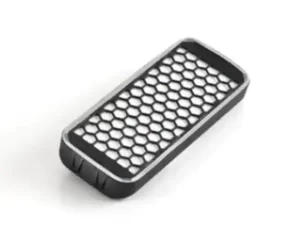
Thermo Scientific™ Replacement HEPA Filter
$205.18 Add to cart View Product DetailsHelp ensure measurable Class 10 air quality performance with Thermo Scientific™ Replacement HEPA Filters and Cleaning Kits.
HEPA Filters
-
- 99.97% filtering at 0.3µm
n
-
- Compatible with all Thermo Scientific™ Forma™ Series II 3110, Thermo Scientific™ Steri-Cycle™, and Forma™ 310 Series (with HEPA filtration system option) incubators
n
-
- Main chamber filter available as a stand-alone or packaged in a group with the other chamber in-line filters
n
Decontamination Kits
-
- n
- Consists of filters for difficult-to-clean chambers and gaskets (except door) and tubing
n
-
- Reduces downtime and labor spent on decontamination
n
-
-
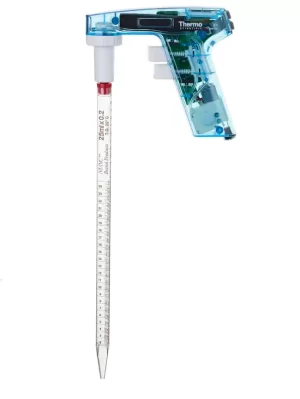
Thermo Scientific™ S1 Pipet Fillers SKU: 9521
$575.43 Add to cart View Product DetailsCarry out longer, fatigue-free pipetting with the Thermo Scientific™ S1 Pipette Fillers. These instruments are ergonomically designed and offer simple, efficient pipetting performance, as well as maximum pipetting comfort. Lightweight and cordless, they feature a heavy-duty rechargeable lithium-ion battery that allows approximately three times longer operation between charges than typical units. For use with graduated and volumetric glass and plastic serological pipets. Monitor Performance
-
- Large, backlit LCD display provides visual confirmation of remaining battery charge and speed settings
n
nControl Speedn
-
- n
- Separate aspirate and dispense speed controls provide precise control over pipetting speeds and reduce risk of overpipetting with smaller pipets
n
-
- Choose from eight speeds with a simple “+” or “-” to adjust pipetting speed which is displayed on the LCD
n
nReady When You Need Itn
-
- n
- Rechargeable lithium-ion battery offers long runtime per charge while eliminating battery memory problems
n
-
- Battery has rapid charge rate of 80% in one hour and delivers up to 15 hours of continuous operation before recharge
n
n
Warranty and Services
n
2-years with web registration
-
-
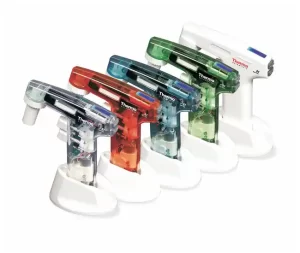
Thermo Scientific™ S1 Pipet Fillers SKU: 9541
$578.23 Add to cart View Product DetailsCarry out longer, fatigue-free pipetting with the Thermo Scientific™ S1 Pipette Fillers. These instruments are ergonomically designed and offer simple, efficient pipetting performance, as well as maximum pipetting comfort. Lightweight and cordless, they feature a heavy-duty rechargeable lithium-ion battery that allows approximately three times longer operation between charges than typical units. For use with graduated and volumetric glass and plastic serological pipets.
-
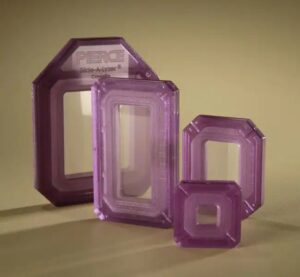
Thermo Scientific™ Slide-A-Lyzer™ Dialysis Cassettes, 20K MWCO
$162.15 Add to cart View Product DetailsSlide-A-Lyzer Dialysis Cassettes (20K MWCO) facilitate the simple and effective removal of buffer salts and small contaminants from proteins and other macromolecules larger than 20,000 Daltons. They are available in four sizes to accommodate sample volumes between 0.5 and 30 mL. These devices are easier to use than traditional dialysis tubing, providing faster buffer exchange, and more complete sample recovery.
nSlide-A-Lyzer Dialysis Cassettes (20K MWCO) facilitate the simple and effective removal of buffer salts and small contaminants from proteins and other macromolecules larger than 20,000 Daltons. They are available in four sizes to accommodate sample volumes between 0.5 and 30 mL. These devices are easier to use than traditional dialysis tubing, providing faster buffer exchange and more complete sample recovery. Slide-A-Lyzer cassettes can be used for a wide range of applications including low-molecular weight contaminant removal, buffer exchange, desalting, equilibrium dialysis, and sample concentration. Liquid samples are easily added and removed by penetrating the self-sealing gasket with a hypodermic needle attached to a syringe. No knots, clips, or caps are needed to seal the units and prevent leaking and sample-loss during the dialysis procedure.
Slide-A-Lyzer Dialysis Cassettes are constructed from two sheets of low-binding, regenerated-cellulose dialysis membrane that are hermetically sealed on either side of a silicone-like gasket inside an inert plastic frame. The membrane and cassette materials are compatible with most common laboratory chemicals and buffers.
Features of Slide-A-Lyzer Dialysis Cassettes:
• Easy to use—no knots or clamps are needed; just inject sample into cassette and begin dialysis
• Fast dialysis—flat cassette chamber with two membranes provides high surface-area to volume ratio that maximizes diffusion rate compared to cylindrical dialysis tubing
• High recovery—rectangular cassette design maximizes recovery of entire sample volume via any one of the four corner injection ports
• Four cassette sizes—select the cassette that best suits your sample volume
• Color-coded—purple cassette frame specifies cassettes with the 20,000 MW pore size membrane
Membrane specifications:
• Composition: regenerated cellulose synthesized by the Viscose method
• Thickness: 0.9 to 1.2 mil (22.5 to 30 µm)
• Hydration time required before use: 2 minutes
• Glycerol content: none
• Sulfur content: 0.04%
• Heavy metals content: trace
Volume ranges:
• 0.5 mL = 0.1 to 0.5 mL
• 3 mL = 0.5 to 3 mL
• 12 mL = 3 to 12 mL
• 30 mL = 12 to 30 mL -
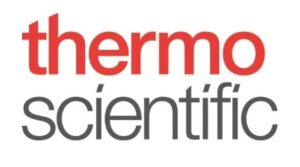
Thermo Scientific™ Stop Solution for TMB Substrates
$140.50 Add to cart View Product DetailsThermo Scientific™ Pierce Stop Solution for TMB is 0.16M sulfuric acid for use with the ELISA substrate 3,3«,5,5« – tetramethylbenzidine (TMB).
nTMB Stop Solution is 0.16M sulfuric acid for use with the ELISA substrate 3,3«,5,5«-tetramethylbenzidine (TMB). Addition of sulfuric acid stop solution changes the color from blue to yellow, stabilizing the color development to enable accurate measurement of the intensity at 450nm using a spectrophotometer or plate reader.
-
- Size: 55mL
n
-
- Sufficient For: five 96-well microplates
n
-
- Application: ELISA
n
Instructions: Following TMB incubation, add an amount of stop solution equal to the amount of TMB substrate added to each well of the ELISA plate (typically 50 to 100µL per well). Use at full strength.
-
-
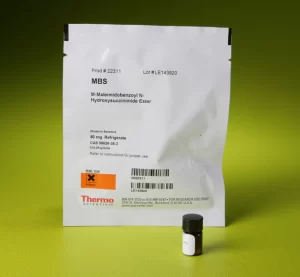
Thermo Scientific™ Sulfo-EMCS (N-ε-maleimidocaproyl-oxysulfosuccinimide ester)
$456.55 Add to cart View Product DetailsThermo Scientific™ Pierce Sulfo-EMCS is a water-soluble amine-to-sulfhydryl crosslinker that contains NHS-ester and maleimide reactive groups at opposite ends of a medium-length spacer arm (9.4 Ås).
Highlights:
- Water-soluble
- Cleavable at pH 8.5 using hydroxylamine and heat
- Lactose dehydrogenase retained 60% of its activity after reversible crosslinking
- Reactive groups: sulfo-NHS esters (homobifunctional)
- Reactive toward: amino groups
-
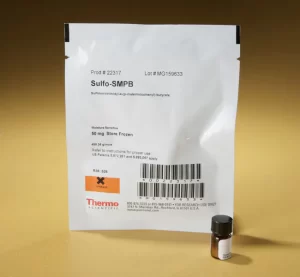
Thermo Scientific™ Sulfo-SMPB (sulfosuccinimidyl 4-(N-maleimidophenyl)butyrate)
$313.95 Add to cart View Product DetailsThermo Scientific™ Pierce Sulfo-SMPB is a water-soluble amine-to-sulfhydryl crosslinker that contains NHS-ester and maleimide reactive groups at opposite ends of a medium-length aromatic spacer arm (11.6 Ås).
Highlights:
- Extended chain length limits steric hindrance
- Water-soluble; membrane-impermeable
- Reactive groups: sulfo-NHS ester and maleimide
- Reactive toward: amino and sulfhydryl groups
-
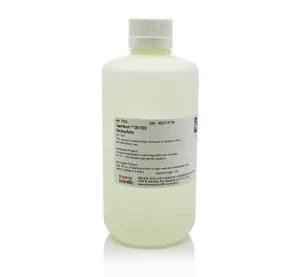
Thermo Scientific™ SuperBlock™ T20 (TBS) Blocking Buffer- SKU: 37536
$317.40 Add to cart View Product DetailsThermo Scientific™ SuperBlock Blocking Buffers are optimized PBS and TBS solutions containing a protein that provides incredibly fast and effective blocking for ELISA, immunohistochemistry and Western blotting applications.
nBlocking microplates, membranes or tissues with a SuperBlock Buffer yields a high signal-to-noise ratio in most detection systems. The protein-based formulation does not contain any immunoglobulins, albumin or endogenous biotin, making it compatible in many situations where traditional blocking agents fail. The buffer is especially effective at blocking coated polystyrene microplates (96-well plates) and stabilizing them for drying and storage for later use.nnHighlights:n
-
- Fast – block membranes in 5 to 10 minutes and ELISA plates in 2 minutes
-
- Flexible – guaranteed to be biotin-free for use with streptavidin system
-
- Convenience – available in multiple buffer formats (in PBS or TBS with or without Tween™-20 detergent) and package sizes (1L, 5L and dry-blend pouches)
-
- Low background – the non-serum protein solution yields a high signal-to-noise ratio
-
- Stable – store buffer at 4°C for one year; store blocked plates dry for up to 12 months
-
-
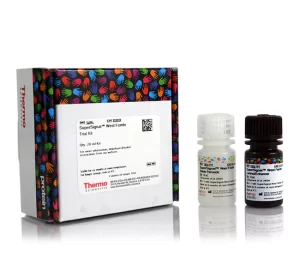
Thermo Scientific™ SuperSignal™ West Femto Maximum Sensitivity Substrate
$161.00 Add to cart View Product DetailsDescription
Thermo Scientific™ SuperSignal West Femto Substrate is an ultra-sensitive enhanced chemiluminescent substrate (ECL substrate) for detection of peroxidase activity from HRP-conjugated antibodies and probes in Western blotting.
nSuperSignal West Femto Substrate Maximum Sensitivity Substrate is an ultra-sensitive chemiluminescent substrate system for Western blotting with horseradish peroxidase (HRP) enzyme. The substrate kit enables detection of low femtogram (that’s mid-zeptomole!) amounts of protein deposited on nitrocellulose or PVDF membrane and probed with appropriate primary and secondary antibodies. When combined with optimized antibody concentrations and blocking buffers, SuperSignal West Femto Substrate enables detection of target proteins in amounts that are small to be seen with typical ECL substrates.nnHighlights:n
-
- n
- ECL substrate – an enhanced chemiluminescent substrate for detection of horseradish peroxidase (HRP) activity from antibodies and other Western blot probes
n
-
- Sensitive – detect low-femtogram (mid-zeptomole) amounts of protein in bands on nitrocellulose or PVDF membranes
n
-
- Quantitative – produces quantitative signal that is measurable over two orders of magnitude
n
-
- Saves on antibody – optimized for very dilute antibody concentrations; dilute primary antibodies 5000- to 100,000-fold and secondary antibodies 100,000 to 500,000-fold (from 1mg/mL stocks)
n
-
- Intense signal – easy to capture an image by exposure to autoradiography film or via a CCD camera or similar imaging system
n
-
- Excellent signal duration – 8 hours of usable light-output when conditions are optimized
n
-
- Stable reagent – kit components are stable for 1 year at 4°C or 6 months at room temperature
n
-
-
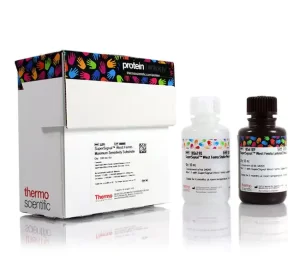
Thermo Scientific™ SuperSignal™ West Femto Maximum Sensitivity Substrate
$502.55 Add to cart View Product DetailsThermo Scientific™ SuperSignal West Femto Substrate is an ultra-sensitive enhanced chemiluminescent substrate (ECL substrate) for detection of peroxidase activity from HRP-conjugated antibodies and probes in Western blotting.
nSuperSignal West Femto Substrate Maximum Sensitivity Substrate is an ultra-sensitive chemiluminescent substrate system for Western blotting with horseradish peroxidase (HRP) enzyme. The substrate kit enables detection of low femtogram (that’s mid-zeptomole!) amounts of protein deposited on nitrocellulose or PVDF membrane and probed with appropriate primary and secondary antibodies. When combined with optimized antibody concentrations and blocking buffers, SuperSignal West Femto Substrate enables detection of target proteins in amounts that are small to be seen with typical ECL substrates.nnHighlights:n
-
- n
- ECL substrate – an enhanced chemiluminescent substrate for detection of horseradish peroxidase (HRP) activity from antibodies and other Western blot probes
n
-
- Sensitive – detect low-femtogram (mid-zeptomole) amounts of protein in bands on nitrocellulose or PVDF membranes
n
-
- Quantitative – produces quantitative signal that is measurable over two orders of magnitude
n
-
- Saves on antibody – optimized for very dilute antibody concentrations; dilute primary antibodies 5000- to 100,000-fold and secondary antibodies 100,000 to 500,000-fold (from 1mg/mL stocks)
n
-
- Intense signal – easy to capture an image by exposure to autoradiography film or via a CCD camera or similar imaging system
n
-
- Excellent signal duration – 8 hours of usable light-output when conditions are optimized
n
-
- Stable reagent – kit components are stable for 1 year at 4°C or 6 months at room temperature
n
-
-
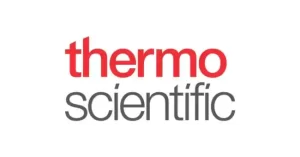
Thermo Scientific™ TMB Substrate Solution
$162.15 Add to cart View Product Details-
- Ready to use, no preparation required
n
-
- Validated for use with Thermo Scientific Pierce Matched Antibody Pairs and MiniKits
n
-
- Size: 100 mL (sufficient for about ten 96-well microplates)
n
-
-
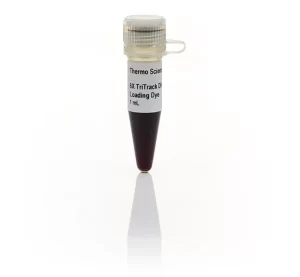
Thermo Scientific™ TriTrack DNA Loading Dye (6X)
$59.51 Add to cart View Product Details6X TriTrack DNA Loading Dye is used to prepare DNA markers and samples for loading on agarose or polyacrylamide gels. It contains three different dyes (bromophenol blue, xylene cyanol FF or orange G) for visual tracking of DNA migration during electrophoresis. The presence of glycerol ensures that the DNA in the ladder and sample forms a layer at the bottom of the well. The EDTA included in the solutions binds divalent metal ions and inhibits metal-dependent nucleases.nn6X TriTrack DNA Loading Dye is used for conventional DNA electrophoresis.
Highlights.
-
- Three-color tracking of DNA migration during DNA electrophoresis
n
-
- No DNA masking during gel exposure to UV light
n
-
- EDTA binds divalent metal ions and inhibits metal dependent nucleases
n
-
-
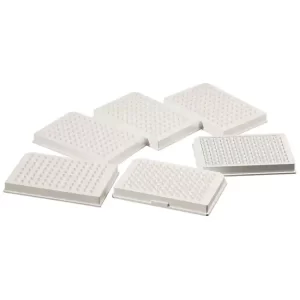
Thermo Scientific™ White 96-Well Immuno Plates
$497.25 Add to cart View Product DetailsConduct quantitative and qualitative immunoassays, like ELISA and binding assays, with Thermo Scientific™ White 96-Well Immuno Plates. These plates, which are compatible with common instruments, deliver optimal results, lot-to-lot reliability and well-to-well reproducibility. Features
-
- Plate has SBS footprint — fits standard equipment
n
-
- Available with flat- or round-bottom wells
n
-
- Choice of three surface types for optimal binding
n
-
- Certified binding homogeneity/reproducibility
n
nChoice of Surface:n
-
- n
- Thermo Scientific PolySorp, Microfluor 1, Microlite 1+ and Universal Binding (UB) for adsorption of hydrophobic molecules
n
-
- Thermo Scientific MaxiSorp is hydrophilic and ideal for antibody sandwich assays
n
-
- Thermo Scientific Microfluor 2 and Microlite 2+ are slightly hydrophilic and bind a diverse range of biomolecules
n
nWhite:n
-
- n
- Gives maximum reflection
n
-
- Minimum autofluorescence and autoluminescence
n
nCompatible with:nnLids for Thermo Scientific MicroWell plates, sealing tape and breathable membrane
-
-
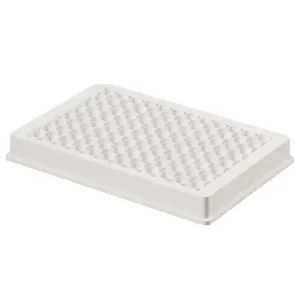
Thermo Scientific™ White 96-Well Immuno Plates
$458.62 Add to cart View Product DetailsConduct quantitative and qualitative immunoassays, like ELISA and binding assays, with Thermo Scientific™ White 96-Well Immuno Plates. These plates, which are compatible with common instruments, deliver optimal results, lot-to-lot reliability and well-to-well reproducibility.Features
-
- Plate has SBS footprint — fits standard equipment
n
-
- Available with flat- or round-bottom wells
n
-
- Choice of three surface types for optimal binding
n
-
- Certified binding homogeneity/reproducibility
n
nChoice of Surface:n
-
- n
- Thermo Scientific PolySorp, Microfluor 1, Microlite 1+ and Universal Binding (UB) for adsorption of hydrophobic molecules
n
-
- Thermo Scientific MaxiSorp is hydrophilic and ideal for antibody sandwich assays
n
-
- Thermo Scientific Microfluor 2 and Microlite 2+ are slightly hydrophilic and bind a diverse range of biomolecules
n
nWhite:n
-
- n
- Gives maximum reflection
n
-
- Minimum autofluorescence and autoluminescence
n
nCompatible with:nnLids for Thermo Scientific MicroWell plates, sealing tape and breathable membrane
-
-

Thermo Scientific™ White 96-Well Immuno Plates
$603.84 Add to cart View Product DetailsConduct quantitative and qualitative immunoassays, like ELISA and binding assays, with Thermo Scientific™ White 96-Well Immuno Plates. These plates, which are compatible with common instruments, deliver optimal results, lot-to-lot reliability and well-to-well reproducibility. Features
-
- Plate has SBS footprint — fits standard equipment
n
-
- Available with flat- or round-bottom wells
n
-
- Choice of three surface types for optimal binding
n
-
- Certified binding homogeneity/reproducibility
n
nChoice of Surface:n
-
- n
- Thermo Scientific PolySorp, Microfluor 1, Microlite 1+ and Universal Binding (UB) for adsorption of hydrophobic molecules
n
-
- Thermo Scientific MaxiSorp is hydrophilic and ideal for antibody sandwich assays
n
-
- Thermo Scientific Microfluor 2 and Microlite 2+ are slightly hydrophilic and bind a diverse range of biomolecules
n
nWhite:n
-
- n
- Gives maximum reflection
n
-
- Minimum autofluorescence and autoluminescence
n
nCompatible with:nnLids for Thermo Scientific MicroWell plates, sealing tape and breathable membrane
-
-

Thermo Scientific™ White 96-Well Immuno Plates
$586.55 Add to cart View Product DetailsConduct quantitative and qualitative immunoassays, like ELISA and binding assays, with Thermo Scientific™ White 96-Well Immuno Plates. These plates, which are compatible with common instruments, deliver optimal results, lot-to-lot reliability and well-to-well reproducibility. Features
-
- Plate has SBS footprint — fits standard equipment
n
-
- Available with flat- or round-bottom wells
n
-
- Choice of three surface types for optimal binding
n
-
- Certified binding homogeneity/reproducibility
n
nChoice of Surface:n
-
- n
- Thermo Scientific PolySorp, Microfluor 1, Microlite 1+ and Universal Binding (UB) for adsorption of hydrophobic molecules
n
-
- Thermo Scientific MaxiSorp is hydrophilic and ideal for antibody sandwich assays
n
-
- Thermo Scientific Microfluor 2 and Microlite 2+ are slightly hydrophilic and bind a diverse range of biomolecules
n
nWhite:n
-
- n
- Gives maximum reflection
n
-
- Minimum autofluorescence and autoluminescence
n
nCompatible with:nnLids for Thermo Scientific MicroWell plates, sealing tape and breathable membrane
-
-
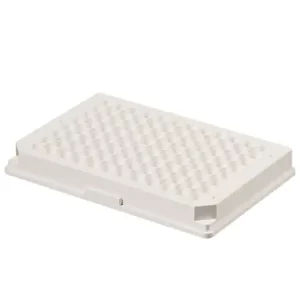
Thermo Scientific™ White 96-Well Immuno Plates
$571.49 Add to cart View Product DetailsConduct quantitative and qualitative immunoassays, like ELISA and binding assays, with Thermo Scientific™ White 96-Well Immuno Plates. These plates, which are compatible with common instruments, deliver optimal results, lot-to-lot reliability and well-to-well reproducibility.
Features
-
- Plate has SBS footprint — fits standard equipment
n
-
- Available with flat- or round-bottom wells
n
-
- Choice of three surface types for optimal binding
n
-
- Certified binding homogeneity/reproducibility
n
nChoice of Surface:n
-
- n
- Thermo Scientific PolySorp, Microfluor 1, Microlite 1+ and Universal Binding (UB) for adsorption of hydrophobic molecules
n
-
- Thermo Scientific MaxiSorp is hydrophilic and ideal for antibody sandwich assays
n
-
- Thermo Scientific Microfluor 2 and Microlite 2+ are slightly hydrophilic and bind a diverse range of biomolecules
n
nWhite:n
-
- n
- Gives maximum reflection
n
-
- Minimum autofluorescence and autoluminescence
n
nCompatible with:nnLids for Thermo Scientific MicroWell plates, sealing tape and breathable membrane
-
-

Thermo Scientific™ White 96-Well Immuno Plates
$567.77 Add to cart View Product DetailsConduct quantitative and qualitative immunoassays, like ELISA and binding assays, with Thermo Scientific™ White 96-Well Immuno Plates. These plates, which are compatible with common instruments, deliver optimal results, lot-to-lot reliability and well-to-well reproducibility.
Features
-
- Plate has SBS footprint — fits standard equipment
n
-
- Available with flat- or round-bottom wells
n
-
- Choice of three surface types for optimal binding
n
-
- Certified binding homogeneity/reproducibility
n
nChoice of Surface:n
-
- Thermo Scientific PolySorp, Microfluor 1, Microlite 1+ and Universal Binding (UB) for adsorption of hydrophobic molecules
n
-
- Thermo Scientific MaxiSorp is hydrophilic and ideal for antibody sandwich assays
n
-
- Thermo Scientific Microfluor 2 and Microlite 2+ are slightly hydrophilic and bind a diverse range of biomolecules
n
nWhite:n
-
- Gives maximum reflection
n
-
- Minimum autofluorescence and autoluminescence
n
Compatible with: Lids for Thermo Scientific MicroWell plates, sealing tape and breathable membrane
-
-
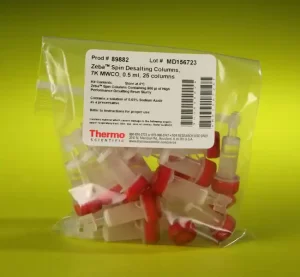
Thermo Scientific™ Zeba™ Spin Desalting Columns, 7K MWCO, 0.5 mL- SKU: 89883
$339.25 Add to cart View Product DetailsThermo Scientific™ Zeba Spin Desalting Columns (7K MWCO) contain a size-exclusion chromatography resin that provides excellent protein desalting performance in a centrifuge format for 2µL to 4mL samples.
nThese specially designed polypropylene centrifuge columns are pre-packed with high-performance Zeba Desalting Resin to facilitate rapid protein desalting with high recovery. The resin effectively traps salts and other small sample components but does not impede proteins and other macromolecules, which pass directly into the centrifuge collection tube. These particular columns use Zeba Resin having a molecular-weight cutoff (MWCO) rating equal to 7K; this ensures that proteins larger than 7000 MW will be recovered with high efficiency.nnThe easy-to-use spin column format dramatically improves results over standard drip-column methodologies. This system eliminates the need to wait for samples to emerge by gravity flow and to monitor fractions for protein recovery. Samples are processed in these desalting columns using a standard centrifuge or microcentrifuge. No chromatography hardware or column preparation steps are required. Multiple samples can be processed in less than 10 minutes. Zeba Spin Desalting Columns are available in five different column sizes, and these provide trouble-free desalting and buffer exchange for sample volumes ranging from 2µL to 4mL
Highlights:
-
- Fast centrifuge format – resin and columns are optimized for rapid processing by centrifugation with standard collection tubes and rotors
-
- Replaces drip-column methods – no need to collect and screen slowly emerging protein fractions
-
- Exceptional protein yields – recover greater than 95% in typical applications with minimal dilution
-
- Five convenient sizes – columns with 75µL to 10mL of Zeba Resin provide desalting matched for sample volumes between 2µL and 4mL
-
- 7K MWCO – resin is rated to recover proteins larger than 7000 daltons and retain (remove) solutes smaller than 1000 MW
Requires:nnMicrocentrifuge and microcentrifuge collection tubes (for 75µL and 0.5mL columns) or centrifuge and collection tubes (15mL tubes for 2 and 5mL columns; 50mL tubes for 10mL columns)
-
-
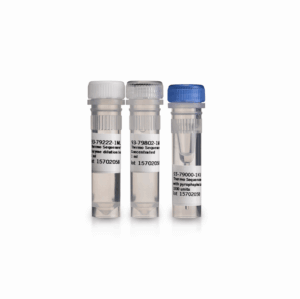
THERMO SEQUENASE DNA 10000UN POLYMERASE, 10000U
$8,561.59 Add to cart View Product DetailsTHERMO SEQUENASE DNA 10000UN POLYMERASE, 10000U
-
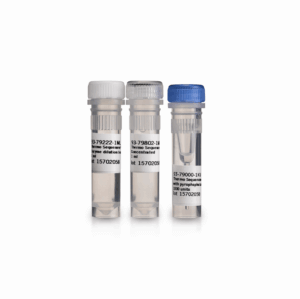
THERMO SEQUENASE DNA POLYMERASE, 1000U
$1,318.63 Add to cart View Product DetailsTHERMO SEQUENASE DNA POLYMERASE, 1000U
